Emyr Williams: ‘Visual, Physical, Spatial: The Work of Robin Greenwood’
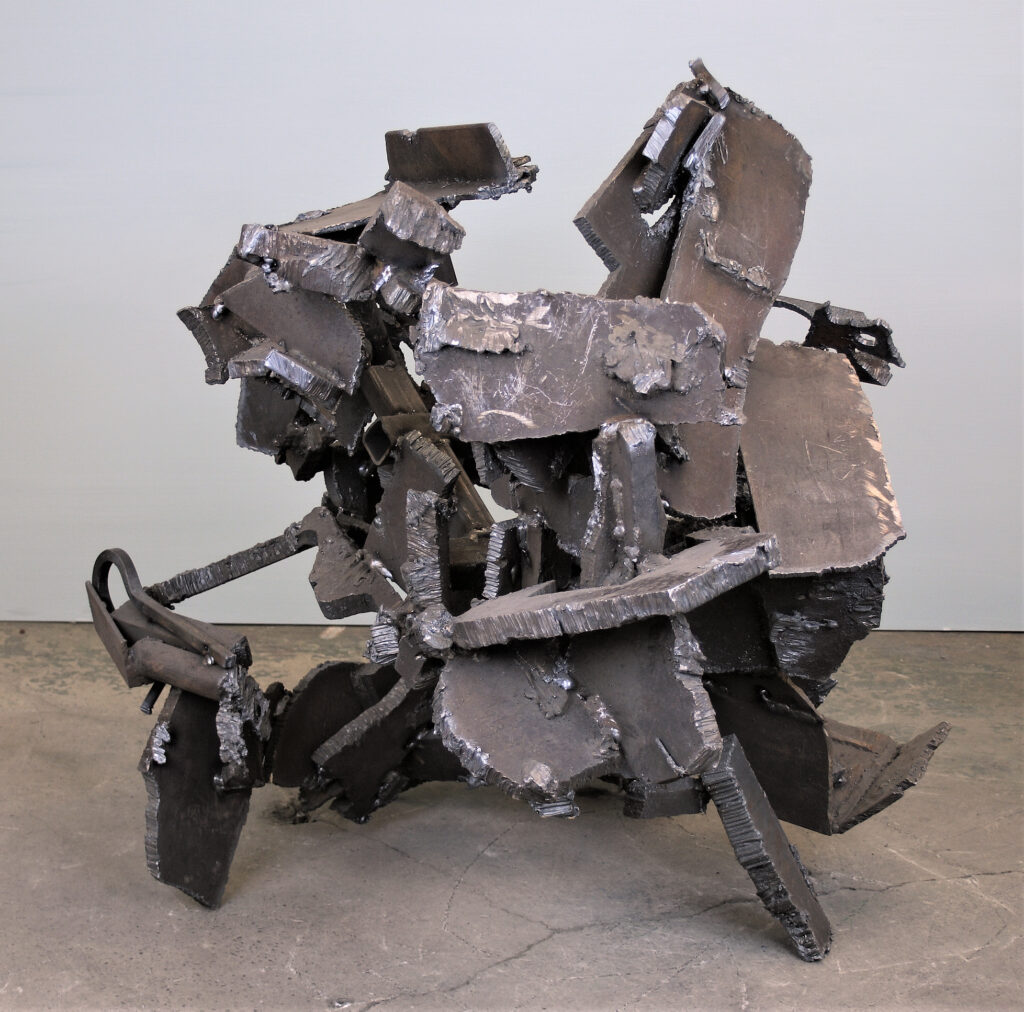
‘Truth and knowledge… arise out of observation and experience rather than manipulation of accepted or given ideas.’ John Locke (Philosopher of the Enlightenment)
The National Curriculum was implemented in 1988-89 by Kenneth Baker during Margaret Thatcher’s free-market-ideological government.
Michael Gove and Nick Gibb (Ministers for Education during the Conservative/Liberal Democrat coalition in 2010) had concerns with what was perceived as a lack of attention to ‘knowledge’ in the curriculum and the dominance of ‘progressivist pedagogy’.
‘Things were so much better back in the sixties, don’t you think? So much deeper and more thoughtful, more serious, and profound. We didn’t, back then, have much of an idea about how to ‘use’ art so shamelessly to ‘express feelings and ideas.’‘
‘The history of abstract art must be open to being problematised in order for us to move on.’
‘The problem is getting the spontaneity into the finished work, rather than into the processes of creating it. The latter is the stock-in-trade of the abstract artist, but it’s easy; the former is much more problematic since a spontaneous working method in no way leads inevitably to a spontaneous end result.’
Robin Greenwood
Somehow the seemingly random statements and quotes above form a series of dots to be joined up to reveal a context and perhaps even a tentative explanation, for where Robin Greenwood- as I see it – was coming from; and also, for why so many contributors to the comment threads beneath essays and reviews- both his and others’- seemed to be riled by certain of his comments or ripostes. For me, however, it stands to reason that if you are an artist working with restless energy, asking demanding questions of yourself on a daily basis within the cut and thrust of studio work, you will be equally forthright and demanding when assessing the practice of others, let alone the wider scene.
Robin was first and foremost a sculptor, and used painting, perhaps, more as a ‘cri de cœur’ (though he did say how integral it had become to his sculpture – indeed it was painting that occupied his last period of work, when the physical demands of making sculpture became too much). He worked tirelessly, all the while under the shadow of his obviously failing health, and for that reason alone we should look very, very closely at his work; the sense of urgency and attack in his most recent work is at times startling to see.
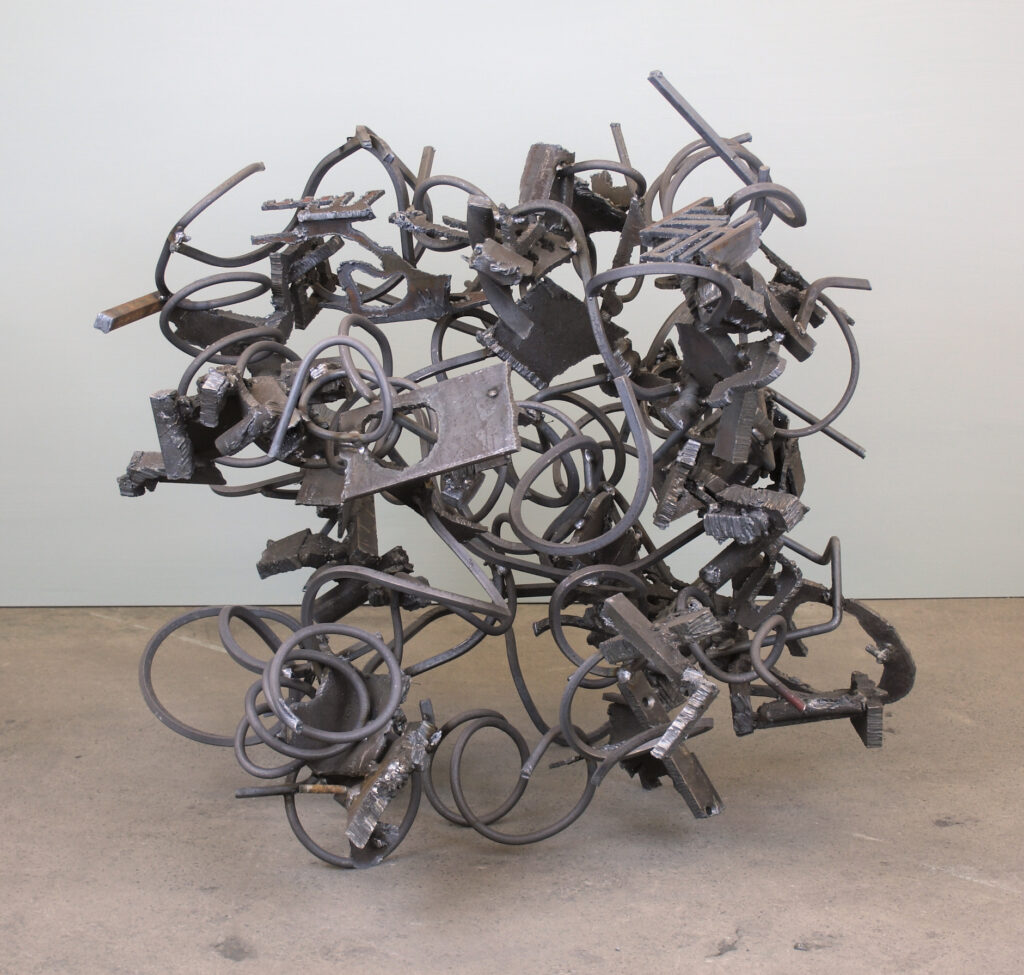
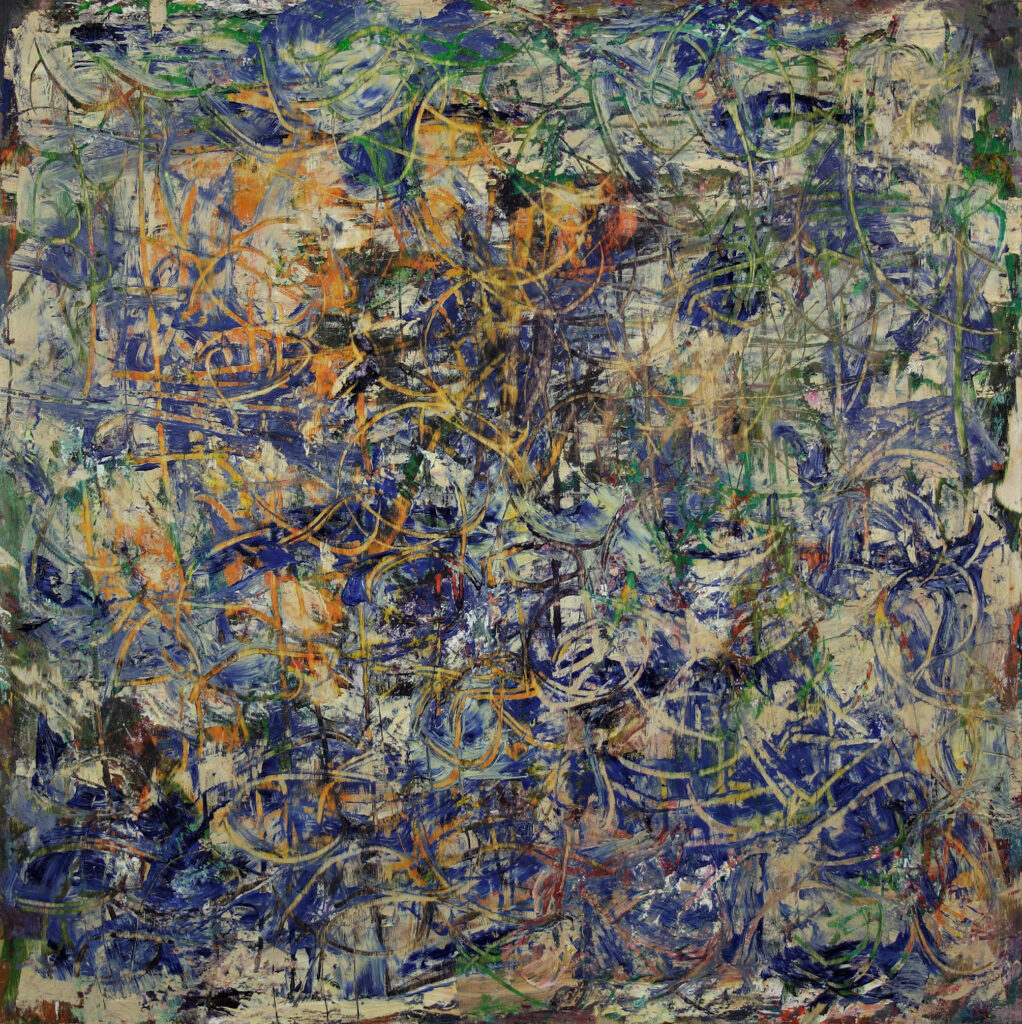
Over several years, this zealous ambition of his gradually took hold. I had always been a frequent visitor to the shows he curated or hosted at the Poussin Gallery and saw some of his own work there. I was co-opted into writing reviews after having contributed a few remarks on comment threads on the remarkable, yet now sadly absent, Abstract Critical.com: a true baptism of fire. Abstract Critical evolved into quite the bear pit for robust, sometimes heated exchanges around abstract art – both contemporary and historical. The reappraisals of mid-century transatlantic art sometimes emerging during exchanges on the site were, for me, eye-opening. As I said to Robin on more than one occasion, I simply didn’t see any of it coming. There were no sacred cows; the hegemony of modernism in abstract painting and sculpture was dismantled, very little was left standing. As Robin saw it, a great many established luminaries had little to offer today’s artists. The latent pictorialism of abstract sculpture took the main brunt of his disaffection, and colour-field flatness as a perceived anaesthetic feature of abstract painting followed quickly after; colour as content was, for Robin, ‘not enough’. Three-dimensionality was the big problem to tackle in sculpture, and deep space the problem to confront in painting (this latter preoccupation of Robin’s seeming to diminish as time went by). Acclaimed artists would often be measured up against Robin’s favourites from the figurative pantheon – painters such as Tintoretto, Constable, Rubens, or Courbet. He often used these artists’ achievements as a ‘jabbing-stick’ to provoke his readers (and other artists). He was challenging us to look again, to demand more and stop simply accepting the status quo and the critical consensus. I was stunned at both the depth of the debate, and the heights it reached. Abstract Critical was a much-needed jolt to the senses at a time when I was looking to reassess my own work.
Robin again invited me to participate in the follow-up site, Abcrit.org, which in turn spawned a sort of Poussin Gallery Mark 2 in the middle floor of his building in Bermondsey (the ground floor having been given over to his studio). He was unfailingly generous to artists that had been excluded from the mainstream of the art world (whatever the hell that is): artists that eschewed the compulsion that is now so sadly prevalent in both the teaching and promotion of art- that of imposing literary narratives on the work in the hope that doing so will deliver ‘meaning’.
Showcasing serious abstract art always requires some serious heavy lifting, whether that be through provision of the necessary financial investment, space, time, or promotion; all of which Robin undertook with energy and integrity. To be clear: you are working against the prevailing culture, which favours the sugar-hit of stage-managed controversy; and as such, you will invite ridicule, disdain, and hostility.
I got to know Robin’s work better through the Brancaster Chronicle crits – the studio discussions he co-founded, which became an annual series of firstly audio-recorded, then filmed critiques around pairs of artists’ works – a chance to sweep out the space, stand back and let the wider world in. These days, though rigorous, were always good-humoured and insightful. At times they were unfairly derided as being carried out in a sort of clique spirit, but nothing could have been further from the truth; several of the artists went back a long way together to their student days, but many more did not. We were quite a disparate bunch and had in common simply the desire to share where we were at a given moment, and to know what others thought of it. It was very much the ‘old school’ critique, not in any way theoretical, rather, an honest appraisal of what the work was ‘doing’ visually. This would be regarded as a formalist approach by some, yet it revealed a connection with how art courses had been run; how all of us had in our own ways, been taught, before the monetising (and diminishing) of education set in.
Brancaster introduced me to artists I had not met or known. Some I mostly agreed with, others less so – that was surely the point? The healthy debate, the disagreement as much as the accord, were in the days’ DNA. I was fascinated by the sculptors’ development, and especially by the ways in which Robin was wrestling with his own work – partly because of the struggles I was having with mine.
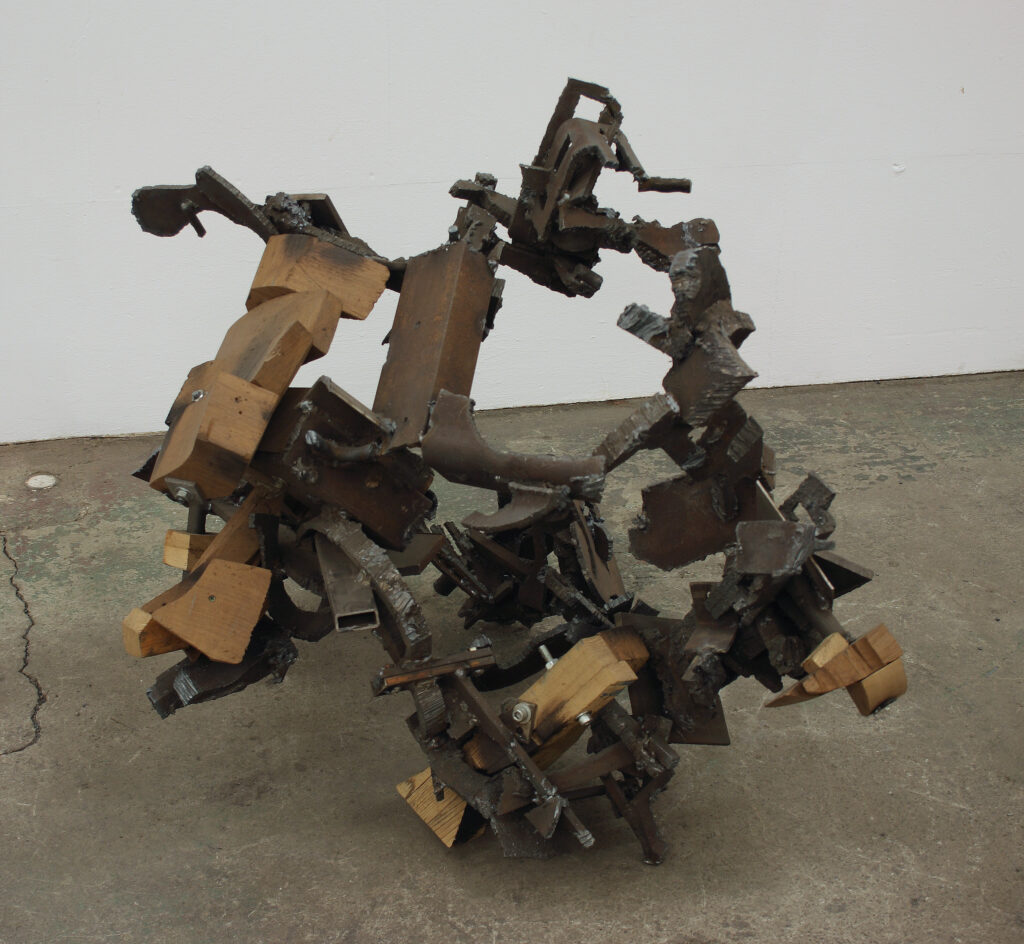
I think Robin’s insistence on ‘getting the spontaneity into the finished work’ best explains his thinking on the kind of approach and level of ambition needed to make good art. He set about working in ways which discarded any notions of configuration, or of the weighing up of one part in relation to another- what sculptor Tony Smart calls ‘flower arranging’– taking him to the point of literally rolling the sculptures over and cutting and welding as if working blindly, which in a way he was. Visual complexity was the goal, and it is a hard-won quality, as so often in this ambition, works can manifest as merely ‘complicatedness’ – it’s a fine line, perhaps, but one on which Robin, fully aware of the pitfalls, was happy to tread. It was also a question of: just how far can we go here? His work seemed to be a clarion call for resistance to what he saw as the comfort blanket of most modernist sculpture, rebuking the notions of lineage and continuity in search of a more ‘human’, more meaningful art form – that in his work, as I mentioned, often looked to certain achievements in painting rather than sculpture as ways of dealing with complexity and three-dimensionality. Such a scrutiny of the problems besetting sculpture was a jolt for me and one which compelled me to take a second look at my own assumptions about painting. Issues which had murmured around the periphery of my thinking started to clarify, somewhat.
Robin – quite rightly – felt an artist must do all the work to provide the viewer with freedom: the freedom to continually discover something new in the work, or rather something that ‘presses’, redefines and reveals unseen or unknown visual qualities. This is not a common goal. Carefully controlled and imposed narratives are the order of the day: I believe they are also a biproduct of a willfully ideologically-manipulated education system that runs like one of our toxic rivers right the way through from primary to postgraduate level and even beyond. I vividly remember my late father (a Reader in Mechanical Engineering at Cardiff University) speaking with horror of how he had been compelled to adjust his teaching to include his ‘aims and objectives’, as if he was some sort of battlefield general briefing his troops. The banality of this systematic controlling of scripted outcomes stinks to this day – and we seem to be still knee-deep, wading through this effluence.
Getting back to clearer and cleaner territory: space within fully three-dimensional forms was a holy grail of Robin’s, but I noticed in his most recent work that it had subsumed itself into a concomitant fact of abstractness, aimed for in the sculpture as a whole, rather than as an isolated ambition; space would happen, but it was not something that needed dealing with in isolation. It was the material that needed dealing with, and the space would follow or rather open up accordingly. An openness was thus achieved through the pressures being delivered by the handling of the material.

I saw Robin as an artist who gravitated more towards the sensibility of Northern European art. As he was often at pains to say, he was not ‘into’ colour as such, in his painting. He was more ‘into’ the facts of paint-as-stuff, and mark-induced detail that sought to activate, and disturb, all parts of the field. I enjoyed the energy in his paintings, perhaps seeing them as protean, seeking freedoms through an improvised, almost insouciant mark-making. The best of them had a strength of purpose and a sly eye for nuance. It was great to see one selected for the John Moore’s- although (and this is in no way a criticism of the work, which was very good) I did wonder if the selectors thought they were picking a landscape of sorts – such is the demise of proper ‘eyes’ on a work, these days, a state of affairs that was evident when you saw what else was on show there.
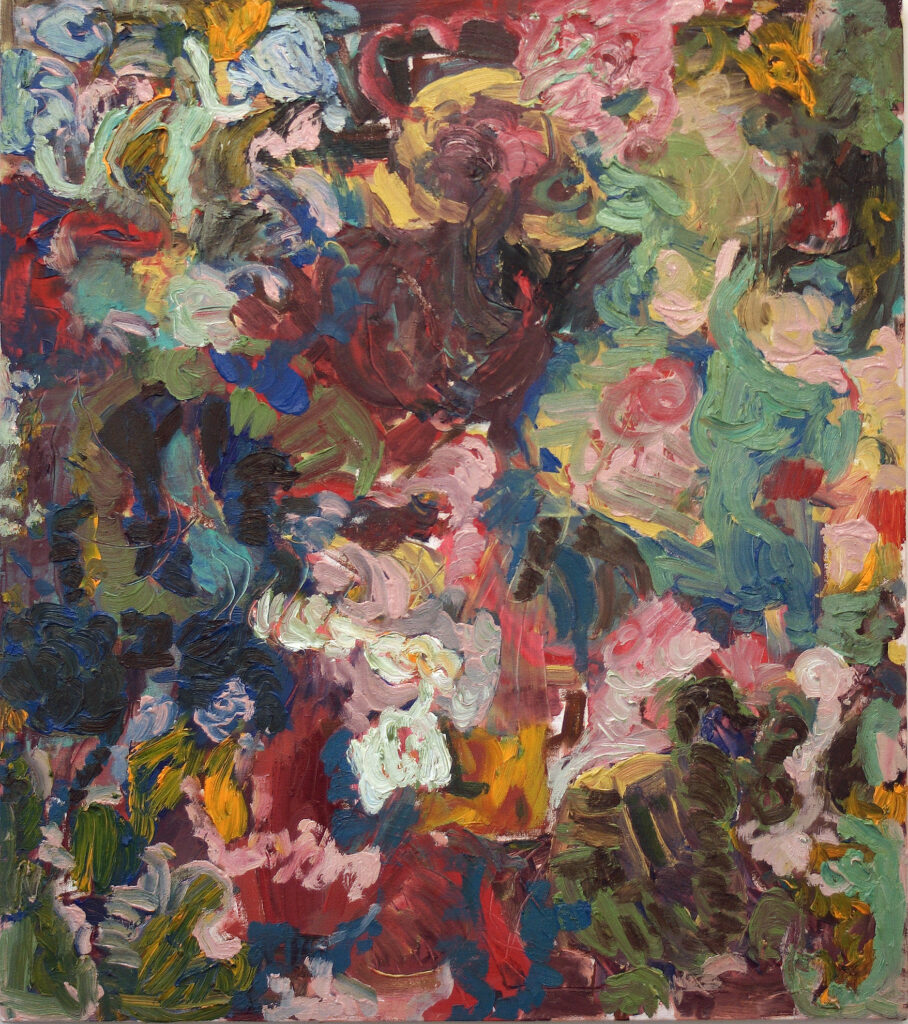
Robin has written that ‘a ‘free-floating’ intentionality in the micro-content of the work is key to my personal approach to making abstract sculpture.’ This attention to the making of such ‘micro-content’ was evident in his paintings, also. He used the familiar tools of brush and palette knife and added to these collagic techniques, attaching pieces of canvas, pre-painted or excised from other paintings – working from a stockpile of discarded canvasses in much the same way as he would from his steel scrap pile). It was an intensely purposeful but frequently wilfully indifferent form of handling, intended to almost blindside himself into creating surprise and incident. His best paintings have a richness in their colouring that only their creator’s long and thorough assimilation of the principles of major figurative painting could have made possible. Cézanne was such an important artist for him, as was Pissarro, their sophisticated responses to three-dimensional space were often singled out for praise. Robin once described Pissarro wonderfully, as ‘possibly the best artist at painting the rise and fall of the land.’ I was surprised to read that Matisse, the supreme colourist, was Robin’s favourite painter; yet it made sense once it dawned on me that the paintings of Matisse that Robin championed sported spatial ‘pressures’ rather than luminous surfaces. The magnificent ‘Safrano Roses at the Window’ of 1925 was a particular favourite.
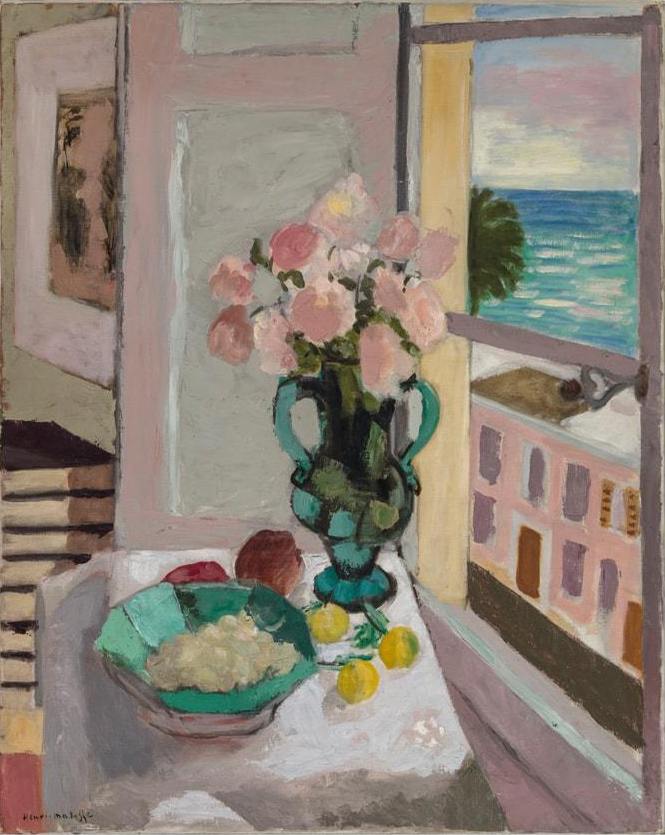
As enjoyable as his painting was, it was his sculpture that spoke with the most authority; the wheeling coils of steel looping around disjointed hunks of found pieces of steel or sometimes roughly hewn, sometimes delicately cut with ‘drawn’ contours of heavy steel plate, which created space through their animated edges and planes. These planes or edges perhaps sometimes meeting the surprise of bolted-in wood, all of which could be jutting, twisting and at times brutally lumbering into evermore complex masses of form. Look closer, though, and very thoughtfully-made, poised adjoinments abounded. The sculptures could often look thrown together, almost haphazard at first glance, yet they possessed a fully resolved logic; not a built or configured one, but a hard-wrought and discovered one. These are works which offer a great lesson, and a direct challenge to modernist sculptural orthodoxy. Movement is pivotal; they compel a physical, moving visual engagement. His hanging sculptures rendered all debate around use of the floor or plinth and how to draw attention to gravity moot by sticking two fingers up at it.
The last works I saw had a much leaner, pared-back quality. Several were on plinths and made solely in steel, with a more emptied centre than in previous sculptures. The steel was twisted, surging into, or holding, space. They were focused, containing their energy through twisting steel ribbons and linear components which moved around the periphery, punctuated by shorter, more abrupt found elements, many of which implied facets, planes, and angularities of negative space in the heart of the work. Skeletal and open, their structure was immediately apprehendable, yet continued to change and surprise as you engaged and moved. Appropriating a definition coined by Nicholas Maxwell, Robin remarked: ‘The freedom of the constructed parts of the work to embody manifold potential actions is ‘the capacity to achieve what is of value in a range of circumstances’. Far from destroying any intended meaning in the work, this more fluid thinking uncovers spontaneous and unexpected aspects to three-dimensional expressivity that can better contribute towards visual/physical/spatial structures absolutely unique to abstract sculpture.’
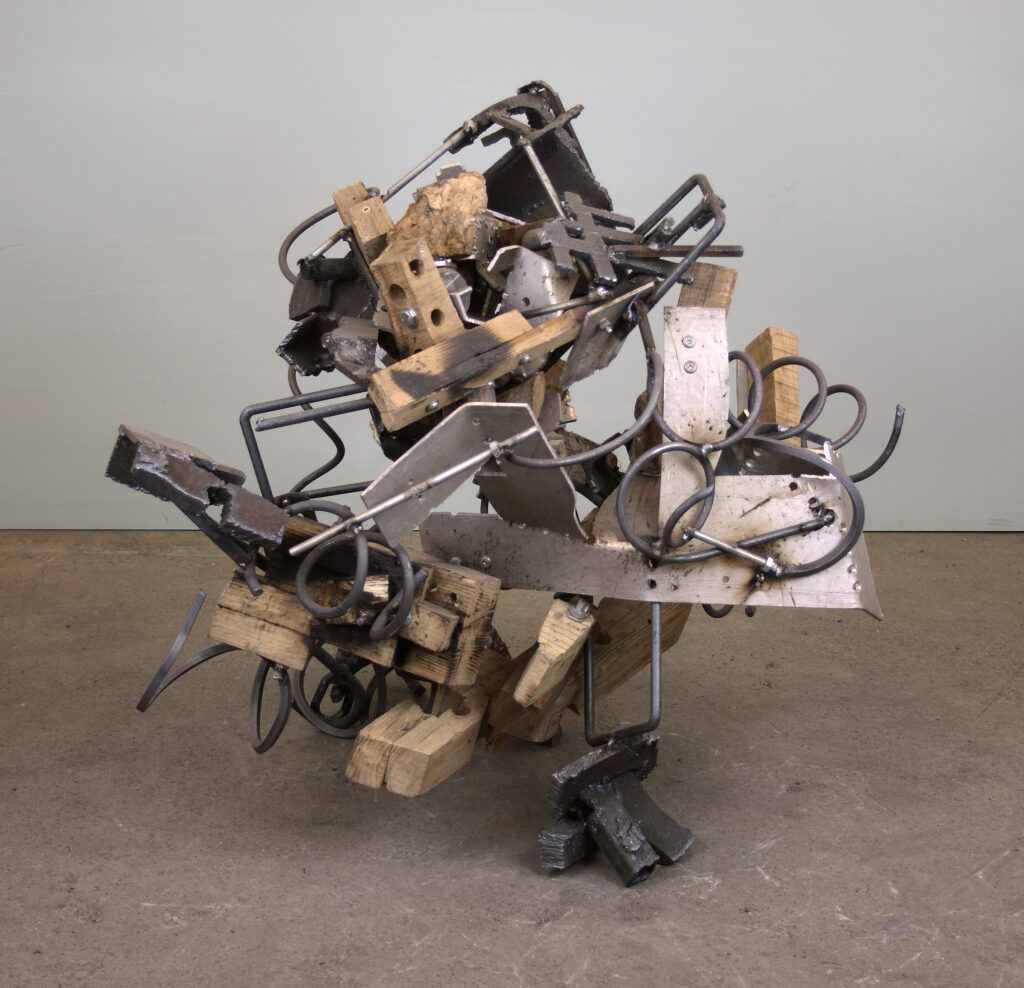
Open sculpture can impart such spontaneous and unexpected aspects to expressivity, but what could be perceived as its freewheeling spontaneity can also lapse into incoherence and jumbled-ness if the scale is unconsidered. In these works, the scale was measured and successful – larger pieces of steel added much-needed changes of pace and weight, stopping the work from becoming too ‘fizzy’. They were hugely assured and hugely rewarding – and at times unsettling, even.
I will miss the visits to see Robin’s work in his studio. I will miss the wit and erudition of his writing and debating, to say nothing of his kindness and unfailing generosity – both professionally and personally. I never really disagreed with Robin’s views. Perhaps I did, as regards the broader definition of what colour is or could be; something I am only just beginning to come to terms with – and this prompting to ask deeper questions about my work is something that I am indebted to him for. Yet this is now, sadly, a debate that cannot happen between us. I am naturally an optimistic person, beaten into a rigidity by the times, at times – as we all are, I’m sure. It’s a bleak scene to behold at the moment, and it just got a little dimmer, with the studio lights not shining in Bermondsey as they once were. Freedom in our work has never been so needed, or so under threat – as it is in our wider lives, also. Robin knew what had been lost – if you had not experienced the environment of a better time in which to be an abstract artist you might not realise what had been taken away from you. The ambition, on the part of all of us, to put this freedom back where it belongs would be a fitting tribute to him and one from which we’d all benefit.
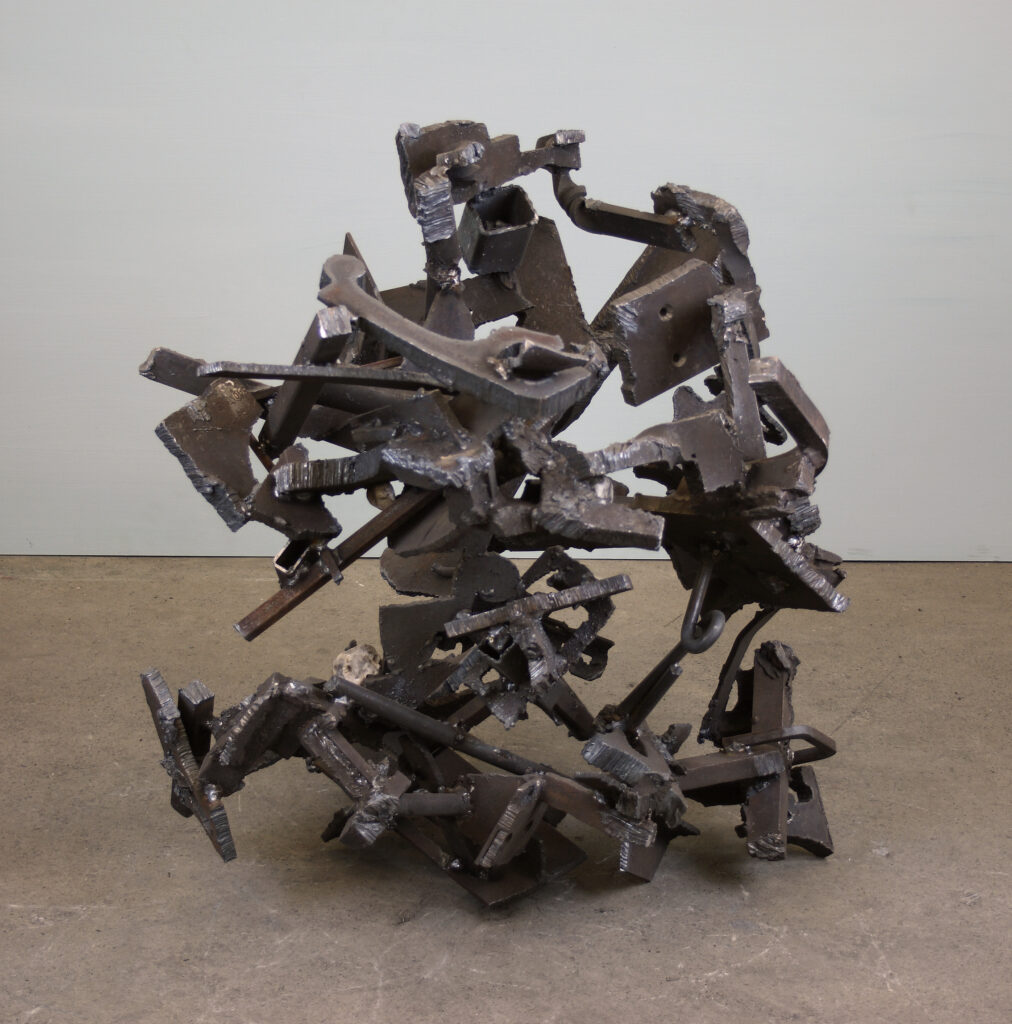
Two last thoughts:
Bob Dylan’s reasoning behind his sculptures’ being based on gates was, apparently, that ‘they can open and close’. ‘Who knew?’ said Robin. That made me laugh out loud.
We exchanged messages in which I ended up saying ‘If I was a sculptor, but then again, no…’
His reply? ‘That’s a little bit funny.’

Robin’s work can be seen virtually at:
www.robingreenwood.com
www.abcrit.org
The Abcrit gallery and Robin’s studio will be open to view his work from late summer onwards, (please email or telephone to make an appointment).
Please note: it was Robin’s last wish that no sculpture or painting presently installed at Abcrit should be photographed for any promotional purposes; if the work was to be seen, then it should be seen in the flesh. There are 27 sculptures and 19 paintings on show.
6 thoughts on “Emyr Williams: ‘Visual, Physical, Spatial: The Work of Robin Greenwood’”
A very generous and beautifully written piece, Emyr. Congrats.
Wonderful writing, Emyr. Great to see his sculptures. I already miss the continual learning which was part of our relationship. He didn’t like my work, I knew, yet from the moment I met him at Wimbledon Art school in the 1970s, he supported me. When I returned from NY in the early 1990s, I rang him to say hello; he and Graham were in Devon in a week. They scratched their heads, looked perplexed, then took me to Budleigh beach, where they threw stones at me. Within a week he offered me a show at Poussin. Nick Serota and Paul Moorhouse came straight away. It was an awkward show, stiffly hung. Then Delfina, where we had lunch with Tony Caro, John and Beverley Hoyland, and Jean, my then new wife. We laughed into the late afternoon. I sold a picture. Life as it should be. Scary that there’s only three of us left now. He even taught me about grieving. I was SO angry that he just left us. It wasn’t until I was watching Aretha’s funeral that I just burst into tears. Stevie Wonder sang ‘I’ll be loving you always’. Pretty much sums it up.
Emyr: congratulations from us too.
We have known Robin and Sarah since we all arrived at St Martins. Over the years we became the best of friends.
Always the debate about abstract sculpture and painting was serious and more than exciting.
He is missed.
The debate will continue.
Yes, Emyr, a wonderful piece. Robin was so full of life. His vitality made it across the Atlantic. Bruce Gagnier has decided–for the moment–that Robin’s paintings are better than his sculpture. Robin might not be happy about that, but Bruce has recognized the importance of what all you guys have been doing from the start. Not everybody over here is as quick on the uptake, but maybe with time. . . Thank you, Emyr. Also thank you Mr. Bunker for Instantloveland. And so nice to hear from Alan and Patrick and Anne and Tony. . .
Emyr, As Tim Scott says, a generous and beautifully written piece, Thank you for taking the time. Robin was important to me, still is. He was a something of curmudgeon and we profoundly disagreed about a whole lot of things, most importantly about the possibility of a totally non-referential work art and about the value of such, even were it to be possible. Never the less, I have great respect and admiration for the work that came from his aspiration to produce such objects and there is no question in my mind that many of his sculptures are significant achievements. I intend to visit the studio when I am in London later this month and I am really looking forward to it.
Thank you Emyr for a well-written, thoughtful and kind of just what I needed article. XX